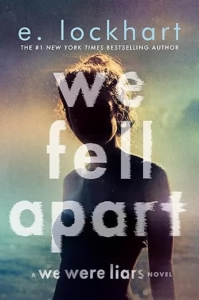We Fell Apart
E. Lockhart
Delacorte Press
Published November 4, 2025
Amazon | Bookshop | Goodreads
About We Fell Apart
This gorgeous edition of We Fell Apart will feature stunning sprayed edges, unique printed endpapers, and an exclusive foil-stamped case!
#1 New York Times bestselling author E. Lockhart returns to the world of her TikTok sensation We Were Liars with all her signature beachy gothic atmosphere, family intrigue, and high-stakes romance.
The invitation arrives out of the blue.
In it, Matilda discovers a father she’s never met. Kingsley Cello is a visionary, a reclusive artist. And when he asks her to spend the summer at his seaside home, Hidden Beach, Matilda expects to find a part of herself she’s never fully understood.
Instead, she finds Meer, her long-lost, openhearted brother; Brock, a former child star battling demons; and brooding, wild Tatum, who just wants her to leave their crumbling sanctuary.
With Kingsley nowhere to be seen, Matilda must delve into the twisted heart of Hidden Beach to uncover the answers she’s desperately craving. But secrets run thicker than blood, and blood runs like seawater.
And everyone here is lying.
My Review
I was so excited to return to the We Were Liars story world, which is weird, because it’s a trauma-filled landscape. I love the characters and the way that everything feels a bit distorted, like looking at a story through funhouse mirrors. While this isn’t a Halloween-themed story, and it has an eerie quality that makes it feel like the perfect October read.
Matilda is great. She’s vulnerable because of her abandonment issues and desperate search for identity and permanence. But she’s fierce and practical and not easily pushed aside or silenced.
When she arrives at her father’s house, she finds a community of people who seem adrift in their own ways. It’s a strange group, and I felt driven to keep reading as much because I wanted to understand why everyone was behaving so strangely as wanting to know whether Matilda would finally meet her father.
At first, the secrets unravel slowly, and they seem fairly innocuous. Okay, so her brother isn’t great at cleaning up after himself. Not too serious. Then, things start to unravel more quickly, and Matilda starts to wonder how deep the treachery goes.
Once I hit the 60% mark, I read straight through to the end of the book. I remember really being enamored with We Were Liars when it came out, but I think I like this book just as much.
Content Notes
Recommended for Ages 13 up.
Profanity/Crude Language Content
Mild profanity used a few times.
Romance/Sexual Content
Kissing.
Spiritual Content
None.
Violent Content
Situations of peril. At one point someone holds a pair of scissors to another person’s throat, threatening them. Someone injects another person with a sedative without their consent. This happens a second time, off-scene. References to a fire that killed several teenagers. (Happens before Matilda reaches the town where it occurred.) References to a car accident that killed two people. A dog kills several young birds. Characters discover the body of someone who has died.
Drug Content
References to addiction and recovery. Matilda and some friends drink alcohol together one night. They wind up sick and faced with terrible hangovers the next day.
Note: This post contains affiliate links, which do not cost you anything to use but help support this blog. I received a free copy of this book in exchange for my honest review. All opinions are my own.
